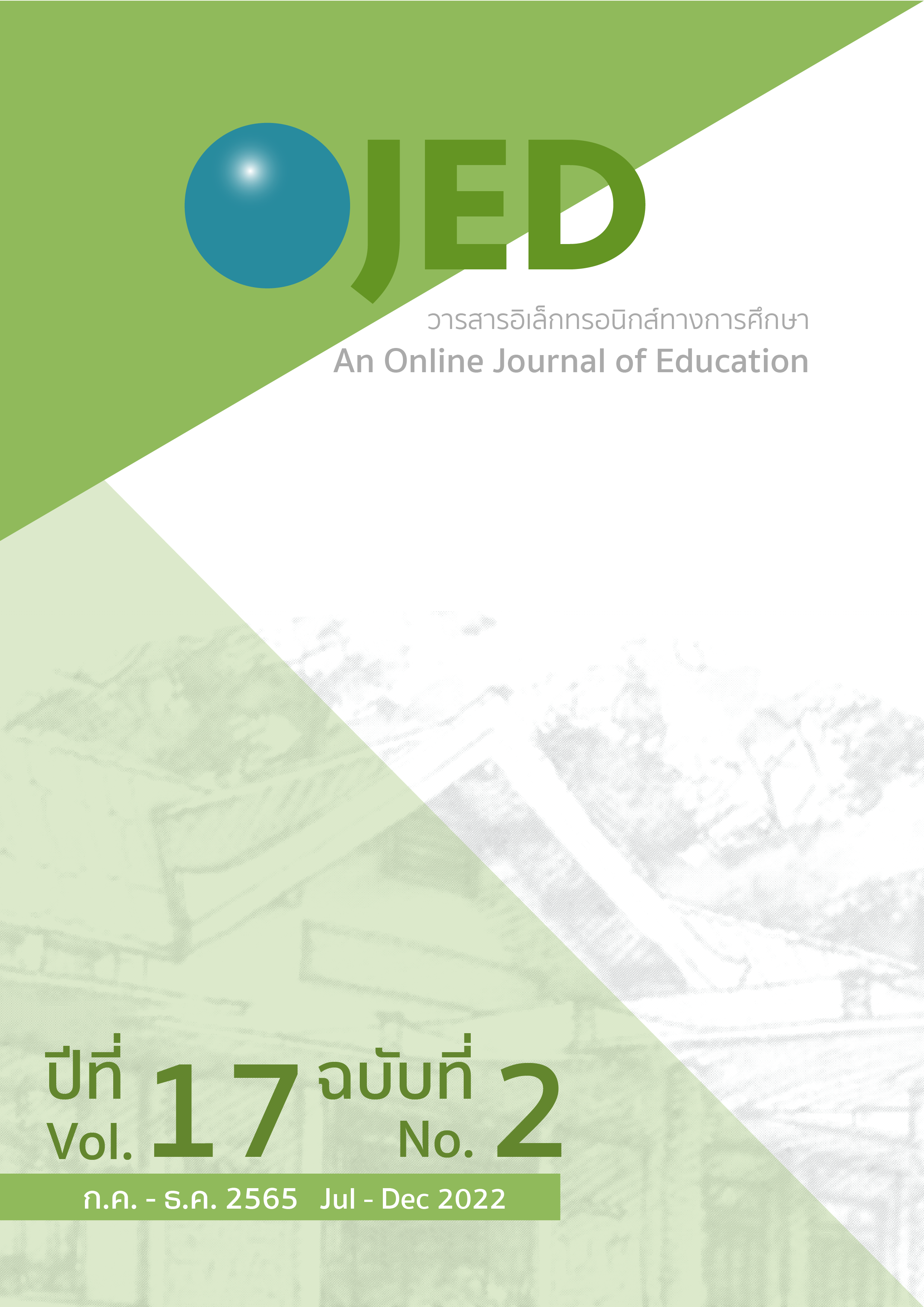Effects of Using Model of Teaching for Abstraction Combine with Visual Learning Strategies on Mathematical Knowledge and Analytical Thinking Ability
DOI:
https://doi.org/10.14456/ojed.2022.55Keywords:
mathematical abstraction, visual learning strategies, mathematical knowledge, analytical thinking abilitiesAbstract
The purposes of this research were 1) to compare the mathematical knowledge of students after learning by using the model of teaching for abstraction combine with visual learning strategies to a criteria of 70 percent, 2) to compare the analytical thinking ability of students after learning by using the model of teaching for abstraction combine with visual learning strategies to a criteria of 70 percent, and 3) to compare the analytical thinking ability of students before and after learning by using the model of teaching for abstraction combine with visual learning strategies. The subjects were 35 tenth-grade students. The instruments used for research were 20 lesson plans, a mathematical knowledge test, the pre-test and post-test of analytical thinking ability tests. The data were analyzed by statistical mean, standard deviation, percentage and the Wilcoxon signed-rank test. The results of the research revealed that 1) the mathematical knowledge of the students after learning by using the model of teaching for abstraction with visual learning strategies were not higher than 70%; 2) the analytical thinking ability of the students after learning by using the model of teaching for abstraction with visual learning strategies were higher than 70% at a .05 level of significance; and 3) the analytical thinking ability of the students after learning by using the model of teaching for abstraction with visual learning strategies were higher than at pre – learning state at a .05 level of significance.
References
กระทรวงศึกษาธิการ (2551). หลักสูตรแกนกลางการศึกษาขั้นพื้นฐาน พุทธศักราช ๒๕๕๑. โรงพิมพ์คุรุสภาลาดพร้าว.
กุลนิดา วรสารนันท์. (2552). ผลของการจัดกิจกรรมการเรียนรู้คณิตศาสตร์โดยใช้โมเดลการอุปนัยที่มีต่อ
มโนทัศน์และความสามารถในการให้เหตุผลทางคณิตศาสตร์ ของนักเรียนมัธยมศึกษาทีที่ 3 [วิทยานิพนธ์ปริญญามหาบัณฑิต]. จุฬาลงกรณ์มหาวิทยาลัย.
กันตพร ขาวแพร และ ชมนาด เชื้อสุวรรณทวี. (2562). การศึกษาความสามารถในการคิดวิเคราะห์ทางคณิตศาสตร์และผลสัมฤทธิ์ทางการเรียน เรื่อง สถิติของนักเรียนชั้นมัธยมศึกษาปีที่ 3 ที่ได้รับการจัดการเรียนรู้โดยใช้วัฏจักรการสืบเสาะหาความรู้. [วิทยานิพนธ์ปริญญามหาบัณฑิต]. มหาวิทยาลัยศรีนครินทรวิโรฒ.
เกรียงศักดิ์ เจริญวงศ์ศักดิ์. (2546). การคิดเชิงวิเคราะห์. ซัคเคสมีเดีย.
จรรยา บุญมีประเสริฐ. (2536). ผลการสอนแบบชี้แนะที่มีต่อความเข้าใจในการอ่านภาษาไทยของนักเรียนชั้นมัธยมศึกษาชั้นปีที่ 4 [วิทยานิพนธ์ปริญญามหาบัณฑิต]. จุฬาลงกรณ์มหาวิทยาลัย
นาเดีย กองเป็ง. (2555). ผลของการจัดกิจกรรมการเรียนรู้โดยใช้กระบวนการแอบสแตรกชันที่มีต่อมโนทัศน์และความสามารถในการให้เหตุผลทางคณิตศาสตร์ของนักเรียนระดับชั้นมัธยมศึกษาปีที่ 2 [วิทยานิพนธ์ปริญญามหาบัณฑิต]. จุฬาลงกรณ์มหาวิทยาลัย.
พิมพันธ์ เดชะคุปต์ และ พเยาว์ ยินดีสุข. (2559). สอนนักเรียนทำโครงงานสอนอาจารย์ทำวิจัยปฏิบัติการในชั้นเรียน. โรงพิมพ์แห่งจุฬาลงกรณ์มหาวิทยาลัย.
ศุภลักษณ์ ครุฑคง. (2556). ผลของการจัดกิจกรรมการเรียนรู้คณิตศาสตร์โดยใช้วิธี IMPROVE และการเขียนบันทึกการเรียนรู้ที่มีต่อความรู้ทางคณิตศาสตร์และความสามารถในการเชื่อมโยงความรู้ทางคณิตศาสตร์ของนักเรียนมัธยมศึกษาปีที่ 2 [วิทยานิพนธ์ปริญญามหาบัณฑิต]. จุฬาลงกรณ์มหาวิทยาลัย.
สมนึก ภัททิยธนี. (2549). การวัดผลการศึกษา. (พิมพ์ครั้งที่ 5). ภาควิชาวิจัยและพัฒนาการศึกษา คณะศึกษาศาสตร์ มหาวิทยาลัยมหาสารคาม
สถาบันส่งเสริมการสอนวิทยาศาสตร์และเทคโนโลยี. (2560). ตัวชี้วัดและสาระการเรียนรู้แกนกลาง กลุ่มสาระการเรียนรู้คณิตศาสตร์ (ฉบับปรับปรุง 2560). โรงพิมพ์ชุมนุมสหกรณ์การเกษตรแห่งประเทศไทย
สถาบันส่งเสริมการสอนวิทยาศาสตร์และเทคโนโลยี. (2562). การแถลงข่าวผลการประเมิน PISA 2018. https://pisathailand.ipst.ac.th/news-12/
สถาบันทดสอบการศึกษาแห่งชาติ .(2562). รายงานผลทดสอบทางการศึกษาระดับชาติขั้นพื้นฐาน (O-NET) ม.6 ปีการศึกษา 2562. http://niets.or.th.
สุวัฒนา เอี่ยมอรพรรณ. (2546). วิธีและเทคนิคการสอนคณิตศาสตร์เพื่อพัฒนาการคิดสำหรับครูในยุคปฏิรูปการศึกษา. จุฬาลงกรณ์มหาวิทยาลัย.
เสงี่ยม โตรัตน์. (2546). การสอนเพื่อเสริมสร้างทักษะการคิดวิเคราะห์. วารสารศึกษาศาสตร์, 1, 26-37.
เสาวลักษณ์ สุวรรณชัยรบ. (2563). ผลการจัดกิจกรรมการเรียนรู้คณิตศาสตร์โดยใช้การเรียนรู้แบบสืบสอบที่มีต่อความรู้ทางคณิตศาสตร์และการคิดอย่างมีวิจารณญาณของนักเรียนมัธยมศึกษาปีที่ 3. [วิทยานิพนธ์ปริญญามหาบัณฑิต]. จุฬาลงกรณ์มหาวิทยาลัย.
Bloom, B. S. (1956). Taxonomy of educational objective book 1: Cognitive domain. Longman Group.
Bruner, J. (1960). The process of education. Harvard University Press.
Hendriana, H., Rohaeti, E. E., Hidayat, W. (2017). Metaphorical thinking learning and junior high school teacher’s Mathematical questioning ability. Indonesian Mathematical Society Journal on Mathematics Education, 8(1), 55-64.
Krulik, S., & Rudnick, A. J. (1993). Reasoning and problem solving : A handbook for elementary school teachers. Allyn and Bacon.
Mitchelmore, M. C., White, P. (2004). Teaching Mathematics concepts: Instruction for abstraction. Invited regular lecture presented at the 10th International Congress on Mathematical Education, Copenhagen, Denmark.
Mitchelmore, M. C., & White, P. (2010). Teaching for abstraction: A model. Mathematical Thinking and Learning, 12(3), 205-226.
Mitchelmore, M. C., White, P., & McMaster, H. (2007). Teaching mathematical concepts: Instruction for abstraction. In J. Watson and K. Beswick (Eds). Proceedings of the 30th Annual Conference of the Mathematics Education Research Group of Australia, Hobart: 503-512.
Raiyn, J. (2016). The role of visual learning in improving students' high-order thinking skills. Journal of Education and Practice, 7(24), 115-121.
Sharma, R. (2021). Visual Learning Strategies. https://learnfromblogs.com/visual-learning-strategies
Starke, K. (2020). The Frayer model: What is it and how to use it. https://www.teachhub.com/teaching-strategies/2020/09/the-frayer-model-what-is-it-and-how-to-use-it/
Downloads
Published
How to Cite
Issue
Section
License
Copyright (c) 2022 An Online Journal of Education

This work is licensed under a Creative Commons Attribution-NonCommercial-NoDerivatives 4.0 International License.




